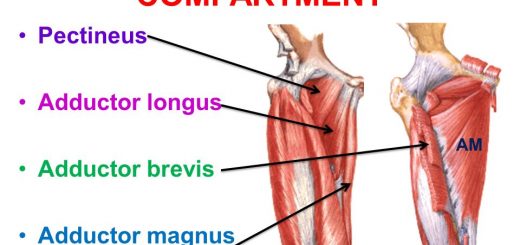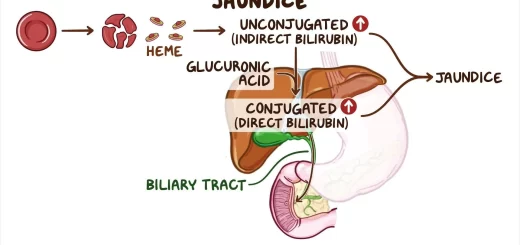Leg nerves types, Injuries of nerves of the lower limb and Sciatica causes
Leg nerves can become inflamed, compressed, or degenerated as a result of mechanical or chemical irritants. Nerves can be damaged due to associated conditions such as diabetes or nutritional deficiencies. Nerve pain is described as sharp, shooting, electric-like, or searing pain. It produces a sensation of hot or warm water running down the thigh and/or leg. In some individuals, a dull ache may occur. The pain may be intermittent or constant.
Leg
The leg receives all its motor, and much of its sensory innervation from the two terminal branches of the sciatic nerve: the tibial and common peroneal nerves. The tibial nerve supplies the muscles of the posterior (flexor) compartment of the leg and the intrinsic muscles of the plantar foot, as well as the skin of the back of the leg (sural nerve) and the plantar skin.
Nerves of the leg
It includes:
- Tibial nerve.
- Common peroneal nerve.
- Superficial peroneal nerve.
- Deep peroneal nerve.
Tibial nerve ( L 4,5 & S 1,2,3 anterior division)
Beginning: It is the larger of the two terminal branches of the sciatic nerve in the lower third of the thigh. End: in the plantar surface of the foot by dividing into medial and lateral plantar nerves (terminal branches).
Course:
In the popliteal fossa (called medial popliteal nerve):
- Enters the fossa through its upper angle and leaves it from its lower angle, running with popliteal artery first lateral then superficial and lastly medial to it.
- The popliteal vein lies between the artery and nerve throughout its course.
In the leg (called tibial or posterior tibial nerve):
- It enters the posterior compartment of the leg between soleus and gastrocnemius muscles above and between the tibia and tibialis posterior below.
- It is named the posterior tibial nerve at the lower border of the popliteus muscle.
- It runs with the posterior tibial artery first medial then superficial and lastly lateral to it.
- It leaves the leg by passing deep to the flexor retinaculum with the posterior tibial artery between flexor digitorum longus and flexor hallucis longus.
Branches:
In the popliteal fossa:
- Muscular: gastrocnemius, plantaris, soleus and popliteus.
- Cutaneous: sural nerve passes between 2 heads of gastrocnemius and descends to the lower part of the back of the leg to pass behind the lateral malleolus and continues on the lateral border of the dorsum of the foot. throughout its course, it is accompanied by a small saphenous vein. It supplies the lower part of the posterior-lateral aspect of the leg (also lateral border of the foot up to the tip of the little toe).
- Articular: to the knee joint (superior medial genicular, middle genicular, and inferior medial genicular).
In the leg:
- Muscular: tibialis posterior, flexor hallucis longus, flexor digitorum longus and soleus.
- Cutaneous: medial calcanean; supplies the skin of the heel.
- Articular: to ankle joint.
- Terminal branches: medial & lateral plantar nerves.
Common peroneal nerve (lateral popliteal) (L 4,5 & S 1,2 posterior division)
Beginning: It is the smaller terminal branch of the sciatic nerve. End: inside peroneus longus lateral to the neck of fibula by dividing into superficial peroneal ( musculocutaneous) and deep peroneal (anterior tibial) nerves.
Course:
- It enters the popliteal fossa through its superior angle.
- It runs downwards and laterally following the medial border of the biceps femoris muscle.
- It leaves the popliteal fossa at its lateral angle.
- It passes behind the head of the fibula & winds around the neck of the fibula (subcutaneous and can be palpable).
Branches:
- Muscular branch: to short head of biceps femoris.
- Cutaneous: Sural communicating branch. The lateral cutaneous nerve of the calf.
- Articular: to knee joint (superior lateral genicular, inferior lateral genicular, and recurrent genicular).
- Terminal: Superficial peroneal (musculocutaneous) nerve. Deep peroneal (anterior tibial) nerve.
Deep peroneal (anterior tibial) nerve
Beginning: one of the two terminal branches of the lateral popliteal (common peroneal) nerve on the lateral side of the neck of the fibula inside peroneus longus. End: by dividing into medial and lateral terminal branches at the dorsum of foot after passing deep to extensor retinaculum on the lateral side of dorsalis pedis artery.
Course:
- It pierces the anterior intermuscular septum to reach the anterior compartment of the leg.
- It descends deep to the extensor digitorum longus.
- It is accompanied with anterior tibial vessels (the nerves are first lateral then superficial and finally lateral to the vessels).
Branches:
- Muscular: tibialis anterior, extensor hallucis longus, extensor digitorum longus, peroneus tertius, extensor digitorum brevis (by its lateral terminal branch).
- Cutaneous: to adjacent sides of 1st and 2nd toes by its medial terminal branch.
- Articular: to the ankle & joints of the foot.
Superficial peroneal (musculocutaneous) nerve
Beginning: one of the two terminal branches of the lateral popliteal (common peroneal) nerve on the lateral side of the neck of the fibula inside peroneus longus. End: by piercing deep fascia and become cutaneous nerve at lower part of the leg it divides into medial and lateral branches.
Course:
- It descends between the peroneus longus and brevis.
- It emerges between the two muscles and descends under the cover of the deep fascia of the leg.
- It is accompanied with peroneal artery.
Branches:
- Muscular:To the peroneus longus & brevis.
- Cutaneous: to the skin of the dorsum of the foot and all toes (except adjacent sides of 1st and 2nd toes by deep peroneal nerve, and the lateral side of the little toe by the sural nerve).
Injuries of nerves of the lower limb
Femoral nerve injury
- Muscles paralyzed.
- Motor loss: Loss of knee extension.
- Sensory loss: On the anterior and medial aspect of the thigh, Medial side of the lower leg, and medial border of the foot up to the ball of the great toe.
Obturator nerve injury
Causes:
- Penetrating wounds.
- Anterior dislocation of the hip joint.
- Obturator hernia.
Muscles paralyzed: All the adductor muscles except for the hamstring part of the adductor Magnus.
Motor loss: Adduction of the thigh.
Sensory loss: Medial side of the thigh.
Injury of the lateral cutaneous nerve of thigh L2,3
- Causes: Compression or inflammation.
- Presentation: Sharp pain in the lateral aspect of thigh, knee, and lower lateral quadrant of the gluteal region.
Injury to the superior gluteal nerve
Muscles paralyzed: Gluteus medius and Gluteus minimus.
Motor loss:
- Loss of abduction of the hip.
- Unilateral injury shows lipping gait and positive Trendelenburg’s sign i.e. drooping of the pelvis on one side when the ipsilateral foot is lifted off the ground.
- Bilateral injury shows a waddling gait.
Injury to the inferior gluteal nerve
Muscles paralyzed Gluteus maximus muscle.
Motor loss:
- Impairment of hip extension and lateral rotation.
- Difficulty in raising the body from sitting or stooping position.
Sciatic nerve injury
Commonly injured in the following conditions:
- Intervertebral disc prolapse.
- Dislocation of the hip joint.
- piriformis syndrome.
- Intramuscular injection.
- Penetrating wound and fracture of the pelvis.
Most lesions are incomplete; 90% of cases involve common peroneal due to its superficial position.
Muscles: Hamstring muscles and all the muscles below the knee.
Motor loss:
- Severe impairment in knee flexion.
- Loss of all movements at the foot.
Deformity: Foot drop due to weight of the foot.
Sensory loss:
- All sensation below-knee below the knee except the medial aspect of leg and foot up to the ball of the big toe.
- Loos of the sensation of the sole makes the patient vulnerable to trophic ulcers.
Sciatica
Pain along with the sensory distribution of sciatic nerve:
- Posterior aspect of the thigh.
- Posterior and lateral sides of the leg.
- The lateral part of the foot.
Causes:
- Prolapse of the intervertebral disc.
- Intra pelvic tumor.
- Inflammation of the sciatic nerve.
Injury to common peroneal nerve
Cause:
- Fracture of the fibular neck.
- Entrapment by leg casts or splints.
Muscles paralyzed: Anterior and lateral muscles of the leg.
Deformity: Equinovarus: the foot is plantar flexed and inverted due to actions of unopposed plantar flexors and invertors.
Sensory loss:
- The anterior and lateral side of the leg.
- Dorsum of foot and digits.
- The medial side of the big toe.
The lateral border of the foot and lateral side of the little toe along with the medial border up to the ball of greet toe is unaffected.
Injury to the tibial nerve
Cause: Rarely injured in fractures of upper end of tibia or penetration wound.
Muscles paralyzed: All muscles of the back of leg and sole.
Deformity: Calcaneo-vulgus: dorsiflexion, and eversion of foot.
Sensory loss:
- Whole of the sole of the foot.
- May result into trophic ulcers.
Leg structure, muscles, nerves, bones, anatomy & function
Popliteal fossa structure, Skeleton of the leg, Shaft & Joints of tibia
Medial compartment of thigh muscles, Growth & regeneration of smooth muscle fibers
Gluteal region structure, muscles, nerves & Posterior compartment of thigh muscles
Smooth muscles types, properties, function & Source of calcium ions in smooth muscle



